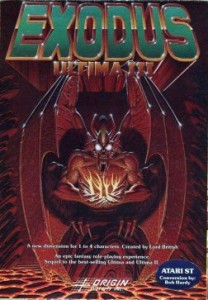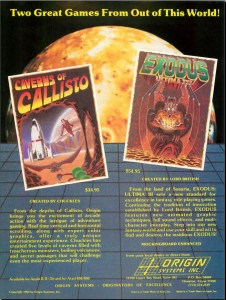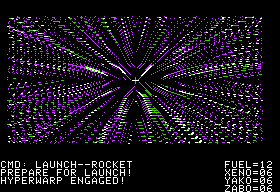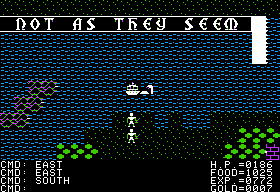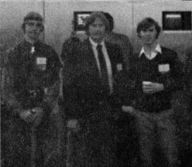
Early days in the garage at Origin. Top row, from left: Ken Arnold, Mike Ward, Laurie Thatcher, James Van Artsdalen, Helen Garriott, John Van Artsdalen. Bottom row: Richard Garriott, Robert Garriott, Chuck Bueche.
When we last checked in with Richard Garriott, he had just released Ultima II under the imprint of Sierra Online. Despite all of the pain and tension of its extended development process and the manifold design flaws that resulted from that, Ultima II proved to be a hit, selling over 50,000 copies within the first year or so and eventually approaching sales of 100,000. Contemporary reviews were uniformly stellar. In contrast to Ultima II‘s modern reputation as the black sheep of the Ultima family, reviewers of the era seemed so entranced by the scope and vision of the game, so much grander than anything else out there, that they were willing to overlook all of the useless spinning gears that didn’t connect with anything else and the many things that just didn’t make sense even by the generous standards of CRPG storytelling. Only one review that I’ve seen takes note of Ultima II‘s strangely disconnected design elements at all, James A. McPherson’s piece for Computer Gaming World. Even he bends over backwards to put the best possible interpretation on it:
My only thought as I finished the game was that very little of this enormous work was really being utilized as being required to finish the game. It was almost as if this was only a small initial quest to give you the lay of the land and that additional scenarios would be released, each one using more of the game until the “Ultimate” quest was finished.
No “additional scenarios” would have a chance to appear even if Garriott or someone at Sierra had read this review and thought it a good idea. As McPherson wrote those words Garriott’s relationship with Sierra was falling to pieces.
As I described in my earlier article, the relationship had been full of tension for months before the release of Ultima II. Big, blustery Ken Williams of Sierra took pretty good care of his people and was beloved by most of them for it, but he never let it be forgot that he considered them his people; he always made it clear who was ultimately in charge. Richard Garriott, younger and quieter than Ken though he may have been, had just as strong a will. He just wasn’t going to be the junior partner in anything. In fact, he even had a small entourage of his own, some of his old running buddies from high school who assisted with his projects in various ways. Most prominent amongst this group were Ken Arnold, Keith Zabalaoui, and Chuck Bueche (immortalized as “Chuckles the Jester” in many an Ultima), the latter two of whom also spent time in Oakhurst at the Sierra offices. Throw in a serious culture clash between the free-spirited California lifestyle of Sierra and the conservatism of Garriott’s suburban Texas upbringing and a final blow-up was probably inevitable. It came just weeks after Ultima II‘s release.
Through much of 1982 Sierra was essentially a two-platform shop. Most of their games were developed on the Apple II, and then those that were successful would be ported to the Atari 8-bit line. (A minority, such as the works of Atari stalwart John Harris, went in the opposite direction.) Accordingly, immediately upon signing Garriott Sierra had not only re-released Ultima I, whose rights they recovered from the now defunct California Pacific as part of the deal, but also funded a port of that game to the Atari machines. Ultima II‘s Atari port was done by prior agreement by Chuck Bueche for a piece of Garriott’s generous royalties. By this time, however, it was becoming clear that Sierra would need to support more than just these two platforms if they wished to remain a major player in the exploding software industry. They therefore funded an additional port of Ultima II, without Garriott’s direct oversight, to the IBM PC. (Another unsupervised port, to the Commodore 64, would follow later in 1983.) The contract he had signed not only allowed Sierra to choose where and when to port Ultima II, but also allowed them to pay Garriott a considerably lower royalty for ports with which he and his entourage were not involved. Effectively he would be paid as the designer only, not as the designer and the programmer. Garriott, who had apparently overlooked this aspect of the contract, felt like he was being swindled even though Sierra remained well within the letter of the law. You can choose to see all of this as you like, as Ken Williams slyly manipulating contract law to put one over on his naive young signee or as a simple failure of due diligence on Garriott’s part.
Regardless, Garriott had consciously or subconsciously been looking for a reason to split with Sierra for some time. Now he had a suitable grievance. Luckily, he had been wise enough to retain the right to the Ultima name. Even Ultima I and II were given exclusively to Sierra only for a few years before reverting back to their creator. There was thus nothing stopping him from continuing the Ultima series elsewhere.
But where? He certainly had no shortage of suitors, among them Trip Hawkins, who pitched hard for Garriott to become one of his electronic artists. Still, Richard wasn’t sure that he wanted to get in bed with yet another publisher at all. He talked it over with his business adviser, his older brother Robert, who in the best over-educated tradition of the Garriott family was just finishing his second Master’s degree at MIT with the thesis “Cross Elasticity Demand for Computer Games.” Robert proposed that they start their own publisher, with him managing the business side and Richard and his buddy Chuck Bueche the technical and creative. And so Origin Systems was born. It would be a little while before they came up with their brilliant slogan — “We Create Worlds” — but just the company name itself was pretty great. It probably owed something to the Origins Games Fair, one of the two most prominent North American conventions for tabletop gamers of all types. Richard, who had played Dungeons and Dragons obsessively in high school and at university in Austin had become an intimate of Steve Jackson Games, had deep roots in that culture. Richard, Robert, their father Owen, and Chuck Bueche all put up money — with the lion’s share naturally coming from the relatively flush Richard — to become the founders of a new games publisher.
Everything about the young (literally; look at their picture above!) Origin Systems was bizarre, even by startup standards. They set up shop in Richard’s personal playhouse, a space above the Garriott family’s three-car garage which had once served as an art studio for his mother but had been commandeered by Richard and his friends years before for their D&D games. It was a big room scattered with desks, chairs, and even cots. Here Richard and his friends set up their various computers. A little cubbyhole at one end served as Robert’s business office. Robert himself was still officially living in Massachusetts with his wife, who had quite a career of her own going as a manager at Bell Labs and thus couldn’t move. Robert, however, was a pilot with a little Cessna at his disposal. He spent three weeks of each month in Houston, then flew back to spend the last with his wife in Massachusetts.
Together Chuck Bueche and Richard worked feverishly on the games that would become Origin Systems’s first two products. Chuck’s was an action game called Caverns of Callisto; Richard’s was of course the big one upon which they were all depending to get Origin properly off the ground, Ultima III.
Given its flagship status, Garriott felt compelled to try to remedy some of the shortcomings of his earlier games. In particular, he was obviously eying the Wizardry series; for all of the Ultima series’s stellar reviews and sales, the first two Wizardry games had garnered even better and more of both. Much of what’s new in Ultima III is there in the name of addressing his series’s real or perceived failings in comparison with Wizardry. Thus he replaced the single adventurer of the early games with a full party which the player must manage; added a new strategic combat screen to make fights more interesting; added a full magic system with 32 separate spells to cast to replace the simplistic system (which the player could easily and safely ignore entirely) of his previous games; added many new class and race options from which to build characters; made some effort to bring some Wizardry-style rigorousness to the loosy-goosy rules of play that marked his earlier games.
Notably, however, Ultima III is also the first Garriott design that doesn’t simply try to pile on more stuff than the game before. Whether because he knew that, what with his family and friends all counting on him, this game needed to be both good and finished quickly or just because he was maturing as a designer, with Ultima III he for the first time showed an ability to edit. Garriott was never going to be a minimalist, but Ultima III is nevertheless only some 60% of the geographical size of Ultima II, the only example of the series shrinking between installments prior to everything going off the rails many years later with Ultima VIII. Also gone entirely is the weird sub-game of space travel, as well as — for the most part — the painful stabs at humor. Yet it’s safe to say that Ultima III will take the average player much longer to finish, because instead of leaving huge swathes of game — entire planets! — dangling uselessly in the wind Garriott this time wove everything together with an intricate quest structure that gives a reason to explore all those dungeons. In fact, there’s a reason to visit every significant area in the game.
Viewed from the vantage point of today, Ultima III is perched on a slightly uncomfortable border, right between the simple early Ultimas that predate it and the deeper, richer works that make up the heart of Ultima‘s (and Richard Garriott’s) legacy today. I don’t know if any other game in the series sparks as much diversity of opinion. To some it’s just a long, boring grind, while a small but notable minority actually name it as their favorite in the entire series. Personally, I can appreciate its advances but take issue with many aspects of its design, which strike me as cruel and rather exhausting. My favorite of the early Ultimas, the one that strikes me as most playable today, remains Ultima I. But I’ll talk about Ultima III at much greater length in a future post. For now let’s just note that it gave CRPG players of 1983 exactly what they wanted — a big, convoluted, epic experience that pushed the technology even further than had the previous game — without the bugs and other issues that had plagued Ultima II.
Having dropped out of even a part-time university schedule and now largely living right there in that garage loft, Richard wrote Ultima III quickly, almost inconceivably so given its technical advancements. It was done in about six months, barely one-third the time invested into Ultima II and considerably less time than it would take many a player to finish it. As usual, the game itself was essentially a one-man effort, but as it came together he recruited family and friends to help with numerous ancillary matters. Ken Arnold, his old buddy from the ComputerLand days, wrote and programmed a lovely soundtrack for the game, playable by those who had purchased one of the new Mockingboard sound cards for their Apple II. A huge advance over the bleeps and farts of the previous games, it was the first of three Arnold-composed soundtracks that have become a core part of Ultima nostalgia for a generation of players, especially once ported to the Commodore 64, where they sounded even better on the magnificent SID chip.
But most of the outside effort went into the package. Origin may have literally been a garage startup, but Richard was determined that their products should not look the part. He wanted to outdo Sierra’s efforts for Ultima II; he succeeded handily. Denis Loubet, whom Richard had met back when he did the original cover art for the California Pacific Akalabeth, now drew a striking demon for the Ultima III cover which might not have had anything obviously to do with the contents of the disks but sure looked cool. (Maybe too cool; lots of overzealous Christian parents would take one look and start sending Garriott letters accusing him of Satanism.) Loubet also provided pictures for the manuals, as did Richard’s mother Helen, who drew up another mysterious cloth map complete with arcane runes along the borders; such maps were about to become another of the series’s trademarks. And did you notice I said “manuals”? That wasn’t a typo. Ultima III included three: a main game manual along with two more booklets containing elaborate faux-medieval descriptions and illustrations for each wizard and cleric spell. Said faux-medieval writing is a bit more tolerable this time because Richard, no wordsmith, didn’t write it himself. The spell descriptions were done by Margaret Weigers, a local friend, while Roe R. Adams III, who was quickly parlaying his reputation as the king of adventure-game players into a career in game development (he would soon sign on to design Wizardry IV for Sir-Tech), doused the main manual in copious quantities of suitably purple prose (yet another Ultima trademark).
As July of 1983 faded into August the game was already largely finished and the various hardcopy pieces were beginning to come in from the printers. Showing that he could challenge even Ken Williams in the charisma department when he wanted to, Richard convinced Mary Fenton and Jeff Hillhouse, two Sierra employees he’d met during his time in Oakhurst, to come join Origin. Fenton would become Origin’s first customer-service person; Hillhouse, who had learned how the industry worked at Sierra, would handle logistics and distribution. When he made contact with distributors and announced Ultima III, everyone was astonished when initial orders totaled no less than 10,000 units. Richard and Robert now kicked their long-suffering parents’ vehicles out of their own garage to make room for a big shrink-wrap machine — their biggest capital investment yet — and a workbench of computers to use for disk duplication. By now Origin had rented a tiny office in Houston to serve as the front that they presented to the world, but the real heart of the company remained there in the garage. For several months evenings in front of the television at the Garriott household would be spent folding together lurid demon-painted boxes.
Ultima III began shipping in late August for the Apple II. Versions for the Atari 8-bit line and the Commodore 64 soon followed. Both ports were done by Chuck Bueche, whose role as a creative and technical force with Origin during these early days was almost as significant as Richard’s. The game was a huge hit across all platforms; Ultima III became the first Ultima to top 100,000 units in sales, a mark that all of the following titles would surpass with ease. Indeed, this moment marks the point where Ultima pulled ahead of the Wizardry series once and for all to become simply the premiere CRPG series of its era. Despite the occasional worthy competitor like the Bard’s Tale series, it would not be really, seriously challenged in that position until the arrival of the officially licensed D&D games that SSI would start releasing at the end of the decade. Happily, Ultima and Richard Garriott would prove worthy of their status; the next Ultima in particular would be downright inspiring.
But for now we still have some business for 1983 and Ultima III. I want to take a closer look at the game, which planted the seeds of much that would follow. First, however, we’ll take a little detour to set the record straight about another one of those persistent myths that dog fan histories of Ultima.
(Richard Garriott’s career has of course been very well documented. The two most in-depth histories are The Official Book of Ultima and Dungeons and Dreamers, even if a distinct whiff of hagiography makes both rather insufferable at times. And of course he’s all over contemporary magazines, not to mention the modern Internet. A particular gem of an article for students of this period in his career is in the November/December 1983 Softline. That’s where I found the wonderful picture at the beginning of this article.)
